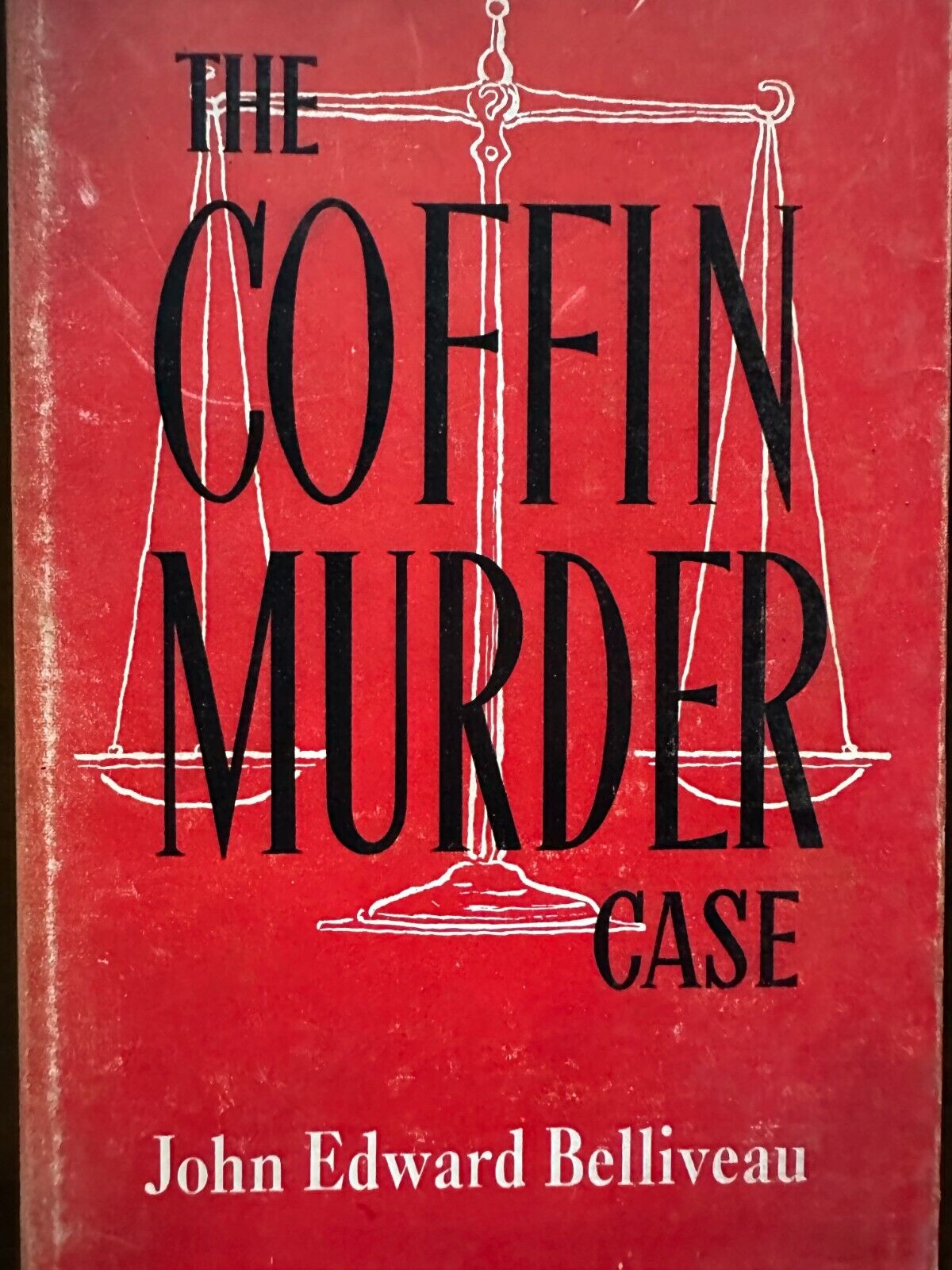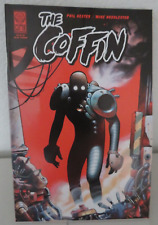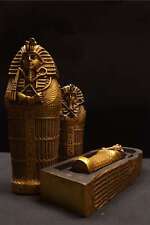When you click on links to various merchants on this site and make a purchase, this can result in this site earning a commission. Affiliate programs and affiliations include, but are not limited to, the eBay Partner Network.
The Coffin Murder Case by John Edward Belliveau 1st Edition 1956 VERY RARE
This is the only 1st edition version for sale anywhere in the world.
Good condition. See photos.
This is not one of the 1979 reprint. This is the actual1st Edition from 1956.
The photos you see here are photos of the actual book that you will receive. Many book sellers online post using stock photos that often don’t resemble the book you actually receive.
This has been deemed a culturally and historically important book.
Please check out the 3600+ comments on our response.
Mr. John Edward Belliveau, a newspaperman with the Toronto Daily Star, published a book titled The Coffin Murder Case, a work of a fine literary and poetic style which did not contain direct and serious accusations against whomsoever in particular but raised very cleverly doubts as to the exactness of the facts laid in proof at Coffin’s trial, suggested, without affirming with strength however, certain facts which might not have been laid in proof and hinted that capital punishment might had been inflicted to an innocent man.
I shall discuss in a distinct chapter of this report Mr. Belliveau’s book to underline some important inaccuracies which might have had serious consequences on public opinion.
Two years later, Mr. Jacques Hébert who, like Mr. Belliveau and Maître Maloney, seem to have been long time supporters of the abolishment of capital punishment, published the first of two books on the Coffin affair, titled Coffin was Innocent; this work being in part inspired, on Mr. Hébert’s own admission, by Mr. Belliveau’s reports (if not by his book?) and by some other newspapermen of Toronto and Pennsylvania from whom Mr. Belliveau had drawn inspiration, reports which were found in what was described as the Toronto Star “Library”; the author (Mr. Hébert) who had also drawn his inspiration partly from information communicated to him by Maître Gravel, took as being his own a good number of affirmations contained in Mr. Belliveau’s book, adding information of his own and made the first violent charges which were already pretty violent.
The Coffin affair was exposed before the public who had not been intelligently, objectively and sufficiently informed on the reasons justifying the judicial decisions which had preceded the final condemnation and execution of Coffin.
In December 1958, a bomb exploded. An Indian known as Thompson, a Canadian citizen native of the St. Regis reservation located on the borders of the Province of Québec and the State of New York, was arrested in Miami on charges of thefts. We shall devote a chapter to the Thompson affair. He accused himself of the murder of the three American hunters perpetrated in the Gaspé bush in 1953. As one might have expected, the Canadian and United States press gave to that confession great publicity. Upon learning about this event, Mr. Hébert and Maître Gravel rushed, the first one on a plane flying to Miami, and the second one, on telephones connected to Miami. A few days later, Thompson unsaid his admissions, explained that he had done so only with the purpose of escaping American justice, and consented to be submitted to a lie detector test, and in circumstances remained obscure, obtained from an American magistrate his liberation.
After this revival of publicity, the Coffin affair remained quiet for a few years; but the curiosity of the public was however kept excited through a program organized and aired by the CBC on CLOSE-UP.
Until that moment, the attention had been retained in great part by the English language television, except for the first book of Mr. Jacques Hébert; time was approaching where French language television and the press would have their turn.
Likewise in Toronto, the publicity bordering on yellow journalism, given to the Coffin affair from 1953 to 1956 resulted in great part, according to a former newspaperman of the Toronto Star, Mr. MacLean, from the frantic competition between two Toronto newspapers, the Toronto Daily Star and the Toronto Evening Telegram, likewise in the Province of Québec, the revival of publicity given to the Coffin affair resulted, indirectly however, from the competition that took place for a few months between two Montreal dailies, La Presse and the Nouveau Journal partly through news and sensational reports.
It appears, from the testimony of Mr. Gérard Pelletier, editor of La Presse, and from Mr. Jean-Guy Lacroix who describes himself as being a freelance newspaperman; the latter was entrusted by his employers La Presse the task of making an inquiry on the activities of the Provincial Police for “special” reports. To this end, Mr. Lacroix thought it necessary to communicate with the former sergeant Doyon of the Provincial Police who, in the beginning of the summer of 1961 had been fired by the Provincial Police. At the time of the murder of the three American hunters, this police officer was in charge of the Gaspé police station. Officers of the Provincial Police came from Québec City, captains Alphonse Matte and Raoul Sirois, were called upon to help him in carrying out an enquiry on the circumstances of the disappearance of three American hunters. This put him out of countenance and humiliated him. As we shall see in a following chapter, Mr. Lacroix’s invitation appears to have been an unforeseen occasion for Mr. Doyon to manifest his rancour towards his former colleagues and Provincial Police superiors which was preying on his mind since his dismissal.
Messrs. Lacroix and Doyon thought that they could obtain from Mr. Jacques Hébert, author of Coffin was innocent, information and advise which might be useful to them. Through the editor of La Presse, they were put in contact with Mr. Hébert and they met him at the office of Mr. Pelletier, in Montréal.
Following this first meeting between Mr. Doyon and Mr. Lacroix, on the one hand, and Mr. Hébert, on the other, the latter started a new enquiry with the manifest purpose, if one may judge by the foreword of Mr. Hébert’s book published in December 1963 under the title I Accuse the Assassins of Coffin, to prove that Coffin was innocent in the manner Mr. Hébert had stated it in his first book, that his condemnation and execution had been a miscarriage of justice and these miscarriages of justice were imputable to the methods used by all officers of justice who had been involved in the preparation and exposition of the proof at Coffin’s trial, starting with the Premier of the time, the Solicitor General of the time and the Assistant Attorney General remained in function since then including the attorneys for the Crown who had acted on behalf of the Crown at the trial, one of Coffin’s attorney, and officers of the Provincial Police who had been in charge of the police enquiry and the preparation of the proof.
In 1963, Mr. Hébert wrote a new book which he launched on the market on the 4th of December 1963 under the title I Accuse the Assassins of Coffin.
It is hardly necessary to underline that a certain number of newspapers and newspapermen eager for news capable of sensational effects and more desirous to help destroy than to help construct, were happy to give Mr. Hébert’s book the greatest publicity possible.
Mr. Hébert’s book was for the least sensational enough with forthright and vitriolic accusations directed against a certain number of persons who had participated in the preparation and the exposition of the proof at Coffin’s trial.
Now, it occurred that when Mr. Hébert’s book was launched, the newspaper La Presse, in Montreal, had already, by virtue of an agreement concluded several months before, the right to reproduce in extenso and in priority, in the newspaper, Mr. Hébert’s book in all or in part, and that certain newspapermen, writers or Radio-Canada producers had obtained from Mr. Hébert, a few days before the marketing of the book, communication of the foul proof.
From the 4th December 1963, the same day Mr. Hébert’s book was launched, Radio-Canada was airing, on its program “Aujourd’hui”, a televised enquiry on certain persons mentioned in the book; a few days later, the newspaper La Presse, in one or two issues, published broad excerpts of the book and another television station, Télé-Métropole, joined the band with its own interviews.
It was no more a few thousand of readers but hundred of thousand, and may be millions of readers, listeners and television viewers that the accusations contained in Mr. Hébert’s book reached, in spite of late efforts from those responsible for the televised enquiry to correct, in the course of the last sitting of their enquiry, the harmful effects of the first two sittings when they realized that they had gone astray, that an enquiry of that sort was manifestly beyond their means and outside of their attributions and might have become a source of injustice.
The Coffin Affair of 1793 was a controversial case in which a group of African-American slaves were arrested in Charleston, South Carolina and accused of planning a slave rebellion through the use of a mysterious coffin. The affair sparked a heated debate in the southern United States at the time, as the accused were denied a fair trial and were ultimately found guilty. Despite the lack of evidence against the accused, public opinion seemed to be overwhelmingly in favor of their guilt, and the slaves were either executed or sold away from their families. This case serves as a stark reminder of the injustice faced by African-Americans throughout history, and why the Coffin Affair was so unjust.
My book L’affaire Coffin: une supercherie? I came to the conclusion that The Coffin’s trial was a hoax in Wilson’s “The Coffin Affair: A Hoax?” ( released by Wilson) in Montreal last November, and I discussed my findings in this article. In PART III of his report, Justice Roger Brossard identifies those behind that hoax. Until the day before Wilbert Coffin’s execution, the case was kept secret. The abolition of capital punishment began as a result of Coffin’s non-guiltiness and the miscarriage of justice that might have resulted in his condemnation, a campaign that was muted but true. The chapter titled “From Belliveau’s Book” will focus on some critical inaccuracies in Mr. Belliveau’s book that could have had serious consequences for public opinion.
Because the public was not informed, intelligently, objectively, and thoroughly about the reasons for the judicial decisions, the Belliveau affair was made public before they were informed. An Indian named Thompson, a Canadian citizen from the St. Regis Indian Reservation, was arrested in Miami on theft charges. The three American hunters were killed in the Gaspé bush in 1953, and he claimed responsibility for their deaths. His admission was immediately dismissed by Thompson as an attempt to escape justice in the United States. He agreed to have a lie detector test, but in some cases the test was not conducted as planned, and he was later released by a US magistrate. Several years passed before the Coffin affair was quietly buried in the aftermath of the revival of publicity. I Accuse the Assassins of Coffin was a new book written by Mr. Hébert that was published in December 1963 and was released on that date.
Mr. Doyon and Mr. Lacroix established a new inquiry with the stated goal of proving Coffin’s innocence following their initial meeting. When the book I Accuse the Assassins of Coffin was published in December 1963, Radio-Canada aired a broadcast detailing the names of the people mentioned in the book. The author wrote, in the first pages of the book, as a warning to the readers, that it contained the most vitriolic lines of the entire book. pp. 8 and 9. If such a miscarriage of justice occurs, the entire country will suffer. He goes on to say that Coffin will be unmasked and punished for those who, conscious or not, are responsible for the three American hunters’ deaths: politicians, civil servants, police officers, and lawyers.
As a result, he says that capital punishment will be completed at the conclusion of this process. It would be unjust and immoral for people who were capable of doing so. A heinous act is committed by a murderer against Coffin with a rare ferocity. Jean-Claude Hébert did not specify how he anticipated that blackmail would stifle the scandal.
The “coffin murder case” is one of the most notorious unsolved mysteries of the 20th century. In October 1922, a woman’s body was found in a sealed coffin in London, England. The coffin had been placed in a public area, and the body was completely unrecognizable. Despite an extensive investigation, the case has never been solved. The woman’s identity has never been established, and the cause of death remains a mystery. To this day, the case still fascinates and confounds experts, who have used modern investigative techniques and forensic science to try and finally solve the case.





